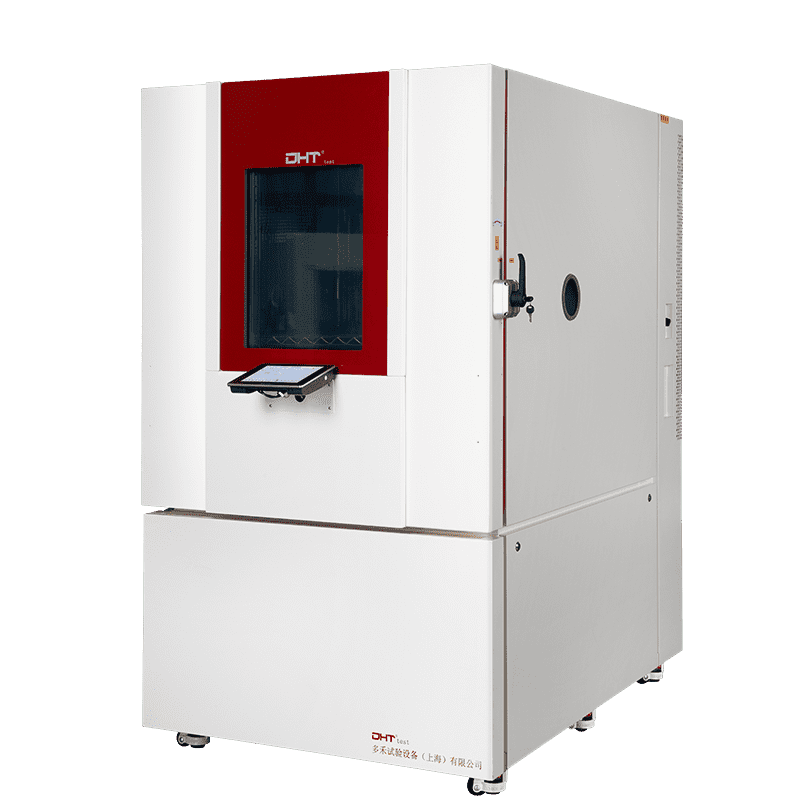Pourquoi l'électronique militaire nécessite des normativas de test environnementaux plus élevés
-
Plage de température extrême (de -65°C à +150°C) pour couvrir les conditions opérationnelles mondiales
-
Taux de montée en température élevée (≥15°C/min) pour simuler le choc thermique en vol supersonique
-
Stress multifactoriel (exposition combinée à l'humidité, basse pression, corrosion et EMI)
-
Tolérance zéro-échec (MTBF ≥ 50,000 heures pour une préparation à long terme) Les chambres de test environnemental servent de « simulateurs de champ de bataille » en laboratoire - permettant aux systèmes de subir des centaines de cycles équivalents de mission avant le déploiement réel.
Chambres à changement de température rapide
1. Conçues pour un cycle thermique rapide, ces chambres mettent à rude épreuve les composants comme les FPGA et les modules radar TR. En utilisant des configurations à trois zones et des systèmes de refroidissement à l'azote liquide, elles offrent des taux de montée ≥30°C/min, reproduisant des profils de normes comme MIL-STD-810H. Elles exposent des défauts critiques tels que les microfissures BGA et le délaminage céramique causé par des CTE mal assortis.
2. Simulent les transitions entre l'humidité tropicale (98% HR) et la sécheresse arctique. Ces chambres testent l'intégrité des connecteurs scellés, des revêtements conformes PCB et de la résistance d'isolation. Le contrôle précis (±0,5°C / ±2% HR) assure la répétabilité sur les axes environnementaux doubles.
3. Utilisées pour tester de grands systèmes comme les stations au sol UAV et les modules EW embarqués. Ces chambres intègrent la simulation de vent (≥18 m/s), la radiation solaire (1120 W/m²), et le bruit EMI ambiant. De tels environnements révèlent des risques au niveau système qui ne peuvent être capturés par des tests de composants uniquement.
4. Imitent des altitudes allant jusqu'à 20 km (≈4,4 kPa) pour tester les seuils de décharge d'arc et la dégradation du refroidissement. Crucial pour les TWTAs aériens et les contrôleurs de puissance spatiales, ces chambres valident les capacités de démarrage à froid dans des conditions proches du vide.
5. En combinant les normes ASTM B117 et GM9540P, ces systèmes simulent des profils de corrosion avancés. Ils sont essentiels pour évaluer les défaillances à long terme dans les radômes en réseau phasé et les rails de lancement de missiles, offrant une meilleure corrélation que les chambres conventionnelles de pulvérisation de sel.
Le rôle des chambres de test environnemental a évolué - de la détection des défaillances au soutien stratégique de la conception :
-
: Les tests HALT aident à identifier des défaillances telles que les défauts de l'oxyde de grille MOSFET dans les modules de puissance.Calibration de jumeau numérique
-
: Les données réelles de contrainte thermique affinent les modèles de comportement des matériaux CAE.Maintenance prédictive
-
: Les ensembles de données thermique-vibration à long terme prévoient la dérive du gyroscope dans les unités INS.Normes d'approvisionnement pour les chambres de qualité militaire
Pour répondre aux exigences critiques de la mission, les organisations de défense doivent évaluer les chambres en utilisant les critères suivants :
-
: Conformité avec les normes mises à jour telles que MIL-STD-461G (EMC), DEF-STAN 00-35 (vibration)Opération continue
-
: Performance non-stop de ≥30 jours avec refroidissement redondant et sauvegarde de double alimentationSécurité des données
-
: Intégration du chiffrement conforme NIST SP 800-171 et du contrôle d'accèsAdaptabilité au champ de bataille
-
: Bases antichoc optionnelles et enceintes antidéflagrantes pour scénarios de test sur le terrainConclusion : Ingénierie de la résilience pour les extrêmes
Dans les systèmes de défense modernes, la fiabilité électrique est synonyme de succès de la mission. Les chambres de test environnemental sont le premier et le plus crucial filtre, exposant les faiblesses bien avant les déploiements réels. Elles offrent aux ingénieurs de la défense la prévoyance pour éviter les défaillances, renforcer les conceptions et assurer l'intégrité opérationnelle.
FAQ
Pourquoi les chambres d'essai environnemental sont-elles cruciales pour l'électronique militaire ?
Les équipements électroniques militaires sont confrontés à des environnements extrêmes tels que les déserts, les plateaux gelés, les hautes altitudes et les déploiements maritimes. Ils doivent supporter de larges plages de températures (-65°C à +150°C), des chocs thermiques rapides, l'humidité, une basse pression et les interférences électromagnétiques. Les chambres d'essai environnementales reproduisent ces conditions de mission en laboratoire, garantissant que les systèmes répondent aux exigences strictes de fiabilité et de tolérance zéro à la défaillance.
Quels types de chambres d'essai environnementales sont utilisés dans les applications de défense ?
Les tests de qualité défense impliquent souvent des chambres à changements de température rapide pour le cyclage thermique, des chambres de température et d'humidité pour la validation des connecteurs et des revêtements, des chambres accessibles pour les grands systèmes comme les stations au sol pour UAV, des chambres à basse pression pour la simulation de haute altitude, et des chambres de corrosion cyclique pour les tests de corrosion avancés. Chaque type répond à des risques critiques pour la mission spécifiques.
Quelles normes et exigences les organisations de défense doivent-elles rechercher dans les chambres d'essai ?
Les chambres environnementales de qualité militaire doivent respecter des normes telles que MIL-STD-810H, MIL-STD-461G (EMC) et DEF-STAN 00-35. Elles doivent prendre en charge un fonctionnement continu (≥30 jours), intégrer un refroidissement redondant et une alimentation de secours, fournir une gestion sécurisée des données conforme à la NIST SP 800-171, et offrir des caractéristiques d'adaptabilité au champ de bataille telles que des bases anti-choc et des enceintes anti-explosion.


